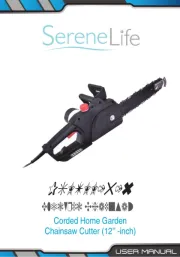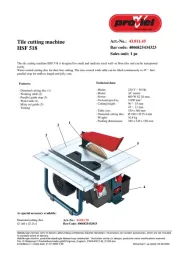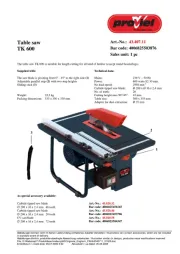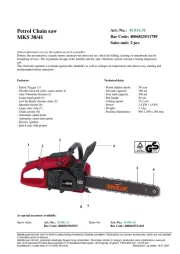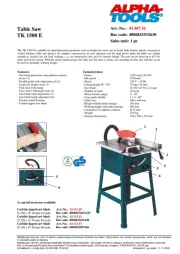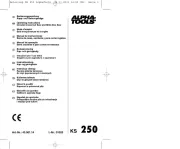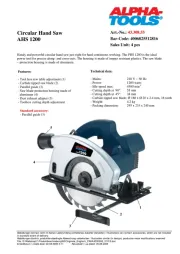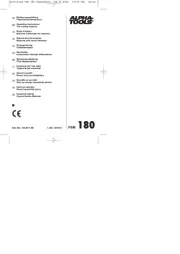GENERAL SAFETY RULES
WARNING: Read and understand all instructions. Failure to follow all instructions listed
below may result in electric shock, fire and/or serious personal injury.
SAVE THESE INSTRUCTIONS
WORK AREA
• Keep your work area clean and well lit. Cluttered benches and dark areas invite
accidents.
• Do not operate power tools in explosive atmospheres, such as in the presence of
flammable liquids, gases, or dust. Power tools create sparks which may ignite the dust or
fumes.
• Keep bystanders, children, and visitors away while operating a power tool.
Distractions can cause you to lose control.
ELECTRICAL SAFETY
• Double insulated tools are equipped with a polarized plug (one blade is wider than
the other.) This plug will fit in a polarized outlet only one way. If the plug does not fit
fully in the outlet, reverse the plug. If it still does not fit, contact a qualified electrician
to install a polarized outlet. Do not change the plug in any way. Double insulation
eliminates the need for the three wire grounded power cord and grounded power supply
system.
• Avoid body contact with grounded surfaces such as pipes, radiators, ranges and
refrigerators. There is an increased risk of electric shock if your body is grounded.
• Don’t expose power tools to rain or wet conditions. Water entering a power tool will
increase the risk of electric shock.
• Do not abuse the cord. Never use the cord to carry the tools or pull the plug from an
outlet. Keep cord away from heat, oil, sharp edges or moving parts. Replace
damaged cords immediately. Damaged cords increase the risk of electric shock.
• When operating a power tool outside, use an outdoor extension cord marked "W-A"
or "W". These cords are rated for outdoor use and reduce the risk of electric shock.
PERSONAL SAFETY
• Stay alert, watch what you are doing and use common sense when operating a power
tool. Do not use tool while tired or under the influence of drugs, alcohol, or
medication. A moment of inattention while operating power tools may result in serious
personal injury.
• Dress properly. Do not wear loose clothing or jewelry. Contain long hair. Keep your
hair, clothing, and gloves away from moving parts. Loose clothing, jewelry, or long hair
can be caught in moving parts. Air vents cover moving parts and should be avoided.
• Avoid accidental starting. Be sure switch is off before plugging in. Carrying tools with
your finger on the switch or plugging in tools that have the switch on invites accidents.
• Remove adjusting keys or wrenches before turning the tool on. A wrench or key that is
left attached to a rotating part of the tool may result in personal injury.
• Do not overreach. Keep proper footing and balance at all times. Proper footing and
balance enables better control of the tool in unexpected situations.
• Use safety equipment. Always wear eye protection. Dust mask, non-skid safety shoes,
hard hat, or hearing protection must be used for appropriate conditions.
TOOL USE AND CARE
• Use clamps or other practical way to secure and support the workpiece to a stable
platform. Holding the work by hand or against your body is unstable and may lead to loss
of control.
• Do not force tool. Use the correct tool for your application. The correct tool will do the
job better and safer at the rate for which it is designed.
• Do not use tool if switch does not turn it on or off. Any tool that cannot be controlled with
the switch is dangerous and must be repaired.
• Disconnect the plug from the power source before making any adjustments,
changing accessories, or storing the tool. Such preventative safety measures reduce
the risk of starting the tool accidentally.
• Store idle tools out of reach of children and other untrained persons. Tools are
dangerous in the hands of untrained users.
• Maintain tools with care. Keep cutting tools sharp and clean. Properly maintained
tools, with sharp cutting edges are less likely to bind and are easier to control.
• Check for misalignment or binding of moving parts, breakage of parts, and any other
condition that may affect the tools operation. If damaged, have the tool serviced
before using. Many accidents are caused by poorly maintained tools.
• Use only accessories that are recommended by the manufacturer for your model.
Accessories that may be suitable for one tool, may become hazardous when used on
another tool.
SERVICE
• Tool service must be performed only by qualified repair personnel. Service or
maintenance performed by unqualified personnel could result in a risk of injury.
• When servicing a tool, use only identical replacement parts. Follow instructions in
the Maintenance section of this manual. Use of unauthorized parts or failure to follow
Maintenance Instructions may create a risk of electric shock or injury.
SPECIFIC SAFETY RULES
• Hold tool by insulated gripping surfaces when performing an operation where the
cutting tool may contact hidden wiring or its own cord. Contact with a "live" wire will
make exposed metal parts of the tool "live" and shock the operator.
The label on your tool may include the following symbols.
V ..........................volts A..........................amperes
Hz ........................hertz W ........................watts
min........................minutes ......................alternating current
......................direct current no ........................no load speed
..........................Class II Construction ........................earthing terminal
........................safety alert symbol .../min ..................revolutions or
reciprocations
per minute
WARNING: Some dust created by power sanding, sawing, grinding, drilling, and other con-
struction activities contains chemicals known to cause cancer, birth defects or other repro-
ductive harm. Some examples of these chemicals are:
• lead from lead-based paints,
• crystalline silica from bricks and cement and other masonry products, and
• arsenic and chromium from chemically-treated lumber. (CCA)
Your risk from these exposures varies, depending on how often you do this type of work. To
reduce your exposure to these chemicals: work in a well ventilated area, and work with
approved safety equipment, such as those dust masks that are specially designed to filter out
microscopic particles.
• Avoid prolonged contact with dust from power sanding, sawing, grinding, drilling,
and other construction activities. Wear protective clothing and wash exposed areas
with soap and water. Allowing dust to get into your mouth, eyes, or lay on the skin may
promote absorption of harmful chemicals.
CAUTION: Wear appropriate hearing protection during use. Under some conditions
and duration of use, noise from this product may contribute to hearing loss.
ADDITIONAL SAFETY RULES: JIG SAWS
• KEEP HANDS AWAY from cutting area. Never reach underneath the material for any
reason.
• KEEP BLADES SHARP. Dull blades may cause the saw to swerve or stall under pressure.
CAT. NO. 7552, JS200, JS300 FORM NO. 611172-00 PRINTED IN CHINA (APR-02)
1-800-54-HOW-TO
1-800-54-HOW-TO
1-800-54-HOW-TO
1-800-54-HOW-TO1-800-54-HOW-TO
BEFORE RETURNING THIS PRODUCT
BEFORE RETURNING THIS PRODUCT
BEFORE RETURNING THIS PRODUCT
BEFORE RETURNING THIS PRODUCT BEFORE RETURNING THIS PRODUCT
FOR ANY REASON PLEASE CALL
FOR ANY REASON PLEASE CALL
FOR ANY REASON PLEASE CALL
FOR ANY REASON PLEASE CALLFOR ANY REASON PLEASE CALL
IF YOU SHOULD EXPERIENCE A PROBLEM
WITH YOUR PURCHASE,BLACK & DECKER
CALL .1-800-54-HOW-TO (1-800-544-6986)
IN MOST CASES, A REPRESENTATIVEBLACK & DECKER
CAN RESOLVE YOUR PROBLEM OVER THE PHONE.
IF YOU HAVE A SUGGESTION OR COMMENT,
GIVE US A CALL. YOUR FEEDBACK IS VITAL
TO THE SUCCESS OF BLACK & DECKER'S QUALITY
IMPROVEMENT PROGRAM.
(544-6986)
VEA EL ESPAÑOL EN LA CONTRAPORTADA.
SAVE THIS MANUAL FOR FUTURE REFERENCE.
INSTRUCTIVO DE OPERACI N, CENTROS DE SERVICIO Y PÓ ÓLIZA
DE GARANTÍA. ADVERTENCIA: LÉASE ESTE INSTRUCTIVO ANTES
DE USAR EL PRODUCTO.
INSTRUCTION MANUAL
Catalog Nos. 7552, JS200, JS300
EXTENSION CORDS
When using an extension cord, be sure to use one heavy enough to carry the current your
product will draw. An undersized cord will cause a drop in line voltage resulting in loss of
power and overheating. The following table shows the correct size to use depending on cord
length and nameplate ampere rating. If in doubt, use the next heavier gauge. The smaller the
gauge number, the heavier the cord
MOTOR
Be sure your power supply agrees with nameplate marking. 120 Volts AC only means your
tool will operate on standard 60 Hz household power. Do not operate AC tools on DC. A rating
of 120 volts AC/DC means that you tool will operate on standard 60 Hz AC or DC power. This
information is printed on the nameplate. Lower voltage will cause loss of power and can
result in over-heating. All Black & Decker tools are factory-tested; if this tool does not operate,
check the power supply.
ASSEMBLY/ADJUSTMENT SET-UP
INSTALLING BLADES
(7552) MANUAL BLADE CHANGE MODELS ONLY USE THESE BLADE TYPES
BEFORE INSTALLING BLADES, TURN OFF AND UNPLUG TOOL.
Loosen (do not remove) the two screws "A" in Figure 1. Ensure the blade teeth are facing
forward and insert the saw blade shank fully into the blade clamp. Slightly tighten screws
alternately to position the blade, then fully tighten screws. To release, turn both screws one
turn counterclockwise.
Minimum Gauge for Cord Sets
Volts Total Length of Cord in Feet
120V 0-25 26-50 51-100 101-150
240V 0-50 51-100 101-200 201-300
Ampere Rating
More Not more American Wire Gage
Than Than
0 - 6 18 16 16 14
6 - 10 18 16 14 12
10 - 12 16 16 14 12
12 - 16 14 12 Not Recommended
S
S
S
S
SS
S
S
S
S
SSi
i
i
i
ii
i
i
i
i
iin
n
n
n
nn
n
n
n
n
nng
g
g
g
gg
g
g
g
g
ggl
l
l
l
ll
l
l
l
l
lle
e
e
e
ee
e
e
e
e
ee
a
a
a
a
aa
a
a
a
a
aan
n
n
n
nn
n
n
n
n
nnd
d
d
d
dd
d
d
d
d
dd
V
V
V
V
VV
V
V
V
V
VVa
a
a
a
aa
a
a
a
a
aar
r
r
r
rr
r
r
r
r
rri
i
i
i
ii
i
i
i
i
iia
a
a
a
aa
a
a
a
a
aab
b
b
b
bb
b
b
b
b
bbl
l
l
l
ll
l
l
l
l
lle
e
e
e
ee
e
e
e
e
ee
S
S
S
S
SS
S
S
S
S
SSp
p
p
p
pp
p
p
p
p
ppe
e
e
e
ee
e
e
e
e
eee
e
e
e
ee
e
e
e
e
eed
d
d
d
dd
d
d
d
d
dd
J
J
J
J
JJ
J
J
J
J
JJi
i
i
i
ii
i
i
i
i
iig
g
g
g
gg
g
g
g
g
gg
S
S
S
S
SS
S
S
S
S
SSa
a
a
a
aa
a
a
a
a
aaw
w
w
w
ww
w
w
w
w
ww s
s
s
s
ss
s
s
s
s
ss
R
R
BLADE CLAMP
SERRE-LAME
PORTA SEGUETAS
ROLLER SUPPORT
GUIDE
ROULEAU PORTEUR
GUIA DE SOPORTE DE
RODILLO
1
AOUICK CLAMP™ BLADE CLAMP
LEVER
LEVIER DU SERRE-LAME QUICK
CLAMPmc
PALANCA DEL PORTA SEGUETAS
QUICK CLAMP™
BLADE
LAME
SEGUETA
2
3
4
TRIGGER SWITCH
INTERRUPTEUR À
DÉTENTE
GATILLO
INTERRUPTOR
LOCK ON BUTTON
BOUTON DE VERROUILLAGE
EN MODE DE
FONCTIONNEMENT
BOTON DE ENCENDIDO
PERMANENTE
SHOE
PATIN
ZAPATA
SCREW
ARRIÈRE
TORNILLO
R
5
R
BLADE STORAGE
RANGEMENT DE
LA LAME
COMPARTIMIENTO
PARA SEGUETAS
DUST BLOWER
CHASSE-SCIURE
SOPLADOR DE POLVO
R











